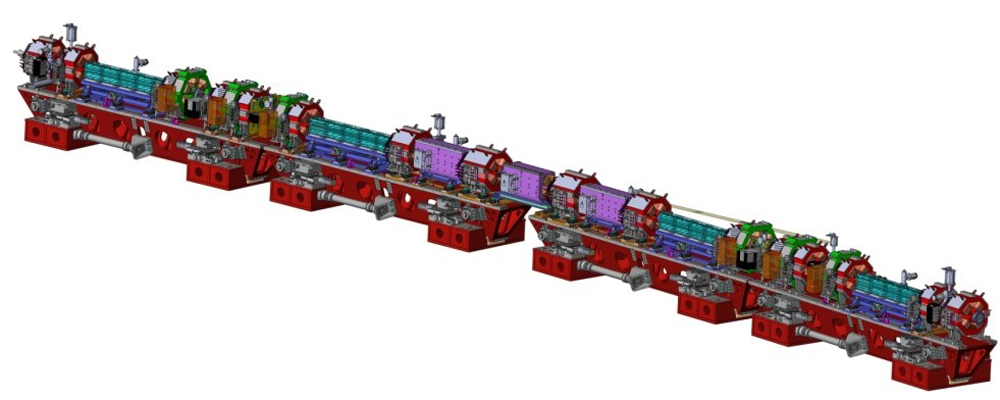- Home
- Users & Science
- Accelerators
- EBS - Extremely Brilliant Source
EBS - Extremely Brilliant Source
EBS (Extremely Brilliant source) represents an investment of 150 M€ over the period 2015-2022.
The principal aim of this project is to construct and commission the new 844 m circumference ESRF-EBS storage ring.
The ESRF storage ring has a circumference of 844 metres and consists of 32 cells, each comprising a long straight section (for the location of the insertion devices) and an arc with a very precise sequence of magnets, vacuum chambers and beam diagnostics. In the new storage ring (ESRF-EBS), the arcs in the cells will be replaced with new arcs whose more complex sequencing will make it possible to create an X-ray source of very low emittance, mainly because the number of bending magnets will be increased from 2 to 7. The full list of detailed EBS parameters (energy, emittance, etc) can be found here.
Independent of decreasing the emittance, the new ring has the following advantages:
- 90% of the existing infrastructure will be re-used
- Improved energy efficiency, reducing energy consumption by 30%
- Performances multiplied by 100 in terms of brilliance and coherence
- An unprecedented tool for the exploration of matter and for the understanding of life at the macromolecular level.
Each cell measures 27 metres and will contain, among other components:
- 14 vacuum chambers (7 in the current ring)
- 31 magnets (currently 19)
- 10 compensating magnets and 10 beam position monitors
The first high-energy fourth-generation synchrotron
The ESRF's Extremely Brilliant source is the first high-energy fourth-generation synchrotron, with X-ray performances increased by a factor 100 compared to the previous synchrotron. This qualitative leap forward will not only open up new fields of investigation for fundamental research, it will also stimulate innovation by permitting improved analysis and understanding of materials with the possibility to efficiently reach spatial resolution at the nanometre level, enabling unprecedented characterisation and understanding of materials and living matter. This exploration of material is an essential prerequisite for understanding the composition of the world around us and for developing new sustainable materials, innovative industrial products and human health treatments in response to the major challenges confronting our society.
The potential fields of application are many:
- nanoscopy for the creation of new materials
- science at extreme conditions (planetary science, technological materials)
- multidimensional (3D, time, chemical, etc.) nano-imaging
- structural biology and health sciences
- materials science
- nanotechnologies
- environmental and energy sciences, etc.
The hybrid 7-bend achromat
The novel hybrid multi-bend achromat (HMBA) lattice design for the storage ring developed by the ESRF will give a horizontal emittance of about 150 pm rad, roughly 30 times lower than the emittance provided by the current double-bend achromat lattice at the ESRF today.
The lattice produces a small emittance mainly because of the increased number of bending magnets (from 2 to 7) but also by combining for the first time a longitudinal gradient in some bending magnets (thanks to stronger focusing, lower field dipoles and dipoles with quadrupolar components) with seven bends and 25 further individual magnets in each of the machine’s 32 cells (dipoles shown in blue, quadrupoles in red and sextupoles in green).
The new lattice replaces the existing storage ring whilst maintaining its circumference, periodicity and beamline positions.
 |
|
The arrangement of the different magnets (on 4 girders) within 1 cell |
The injector upgrade
The injector complex has also been upgraded for ESRF-EBS, including a reduction in the booster circumference of 105mm in order to match the new, higher RF frequency. This will be achieved by displacing each girder 17mm inwards and adapting the injection and extraction points. New hardware, including four new RF cavities and a new Ramped Injection Power Supply (RIPS), has also been installed to enable future operation in top-up mode (link to section on top-up under operation). With RIPS, the cycling frequency will be reduced from 10 Hz to 4 Hz. In order to reduce beam losses during injection, the emittance of the booster needs to be minimized. This will be done by operating the booster with a coupling factor 1 and running it ‘off energy’ by changing the frequency by 40 KHz. With these changes the emittance of the booster will be reduced from 120 nm*rad to 34 nm*rad.



